Monacor CU-40R Handleiding
Monacor
Controller
CU-40R
Bekijk gratis de handleiding van Monacor CU-40R (4 pagina’s), behorend tot de categorie Controller. Deze gids werd als nuttig beoordeeld door 52 mensen en kreeg gemiddeld 4.6 sterren uit 26.5 reviews. Heb je een vraag over Monacor CU-40R of wil je andere gebruikers van dit product iets vragen? Stel een vraag
Pagina 1/4

LED-Controller und
Funk-Fernbedienung
Bitte lesen Sie diese Anleitung vor der Installation
gründlich durch und heben Sie sie für ein späteres
Nachlesen auf.
1 Einsatzmöglichkeiten
Der LED-Controller CU-40R dient zum Ansteuern von RGB-
oder RGBW-LED-Streifen. Er wird per Funk (868 MHz) über
die Fern bedienung CU-40T bedient. Es stehen 10 Steuer -
zonen zur Verfügung. Mehrere Controller lassen sich wie
gewünscht den Zonen zuweisen und können so über eine
Fernbedienung einzeln oder in Gruppen angesteuert werden.
Zur Aufbewahrung der Fernbedienung liegt eine Wand -
halterung bei.
1.1 Konformität und Zulassung
Hiermit erklärt MONACOR INTERNATIONAL, dass sich die
Geräte CU-40R und CU-40T in Übereinstimmung mit den
grundlegenden Anforderungen und den übrigen einschlägi-
gen Bestimmungen der Richtlinie 1999/5/EG befinden. Die
Konformitätserklärungen können bei MONACOR INTERNA-
TIONAL angefordert werden. Die Geräte sind für den Betrieb
in den EU- und EFTA-Staaten allgemein zugelassen und
anmelde- und gebührenfrei.
2 Wichtige Hinweise für den Gebrauch
Die Geräte (Controller, Fernbedienung) entsprechen al len re-
levanten Richtlinien der EU und sind deshalb mit gekenn-
zeichnet.
GDie Geräte sind nur zur Verwendung im Innen bereich ge-
eignet. Schützen Sie sie vor Feuchtigkeit und Hitze (zuläs-
siger Einsatztemperaturbereich 0 – 40 °C).
GVerwenden Sie zum Säubern nur ein trockenes, weiches
Tuch, niemals Wasser oder Chemikalien.
GBei längerem Nichtgebrauch der Fernbedienung die Batte-
rien sicherheitshalber her ausnehmen, damit die Fernbe-
dienung bei einem eventuellen Auslaufen der Batterien
nicht beschädigt wird.
GWird ein Gerät zweckentfremdet, falsch an ge schlossen
bzw. bedient, überlastet oder nicht fachgerecht repariert,
kann keine Haftung für daraus resultierende Sach- oder
Personenschäden und keine Garantie für das jeweilige
Gerät übernommen werden.
3 Inbetriebnahme
Den Controller ggf. an geeigneter Stelle montieren. Die Ab-
deckungen über den Klemmen ab schrauben.
Ist die Steckbrücke (1) auf beide Pins gesetzt, arbeitet der
Controller im 3-Kanal-Betrieb (RGB). Ist sie nur auf einen Pin
gesetzt, arbeitet er im 4-Kanal-Betrieb (RGBW).
Sollen die Geräte endgültig aus dem Betrieb genom-
men werden, übergeben Sie sie zur umweltgerechten
Entsorgung einem örtlichen Recyclingbetrieb.
CU-40R Bestellnummer 38.6620
CU-40T Bestellnummer 38.6610
®MONACOR INTERNATIONAL GmbH & Co. KG • Zum Falsch 36 • 28307 Bremen • Germany Copyright ©by MONACOR INTERNATIONAL. All rights reserved. A-1452.99.01.08.2013
4
5
6
7
8
9
10
11
21 3
Den Controller nach der Abbildung unten anschließen:
– Ein LED-Streifen wird folgendermaßen an die Klemmen
OUTPUT angeschlossen:
RED
-
= Minuspol Rot,
GREEN
-
= Minuspol Grün,
BLUE
-
= Minuspol Blau
WHITE
-
= Minuspol Weiß (bei RGBW-Betrieb)
Den Pluspol des LED-Streifens mit einer Klemme + ver -
binden.
Achtung: Die Belastung pro Farbausgang darf 5 A nicht
überschreiten.
– Ein stabilisiertes Netzgerät an die Klemmen INPUT an-
schließen. Das Netzgerät auf die Betriebs span nung der an-
geschlossenen LEDs einstellen (min. 12 V , max. 36 V ).
Es muss den Strom liefern können, der für den Betrieb der
LEDs benötigt wird plus einen Versorgungsstrom von
80 mA für den Controller.
Die Abdeckungen wieder anschrauben.
Zur Stromversorgung der Fernbedienung den Batteriefach-
deckel auf der Rückseite entfernen und drei Batterien 1,5 V,
Größe Micro (AAA) einsetzen, mit den Plus- und Minuspolen
wie im Fach aufgedruckt.
4 Controller einer Steuerzone zuweisen
Damit der Controller bedient werden kann, muss er einer Zo-
nentaste (11) der Fernbedienung zugewiesen werden. Sind
bis zu 10 Controller CU-40R im Einsatz, kann jeder einer an-
deren Zone zu gewiesen und so einzeln angesteuert werden.
Es ist je doch auch möglich, mehrere Controller derselben
Zone zuzuweisen, um sie gemeinsam zu steuern.
Folgende Bedienschritte zügig nacheinander durchführen:
1) Leuchtet die Betriebsanzeige (4) der Fernbedienung nicht,
die Fernbedienung mit der Taste (9) aktivieren (Hin-
weis, Kapitel 5).
2) Am Controller die Taste LEARNING KEY (3) kurz drücken,
die STATUS LED (2) leuchtet.
3) Die Zonentaste (11), welcher der Controller zugewiesen
werden soll, kurz drücken.
4) Den Farbring (5) berühren. Die STATUS LED blinkt einige
Male zur Bestätigung der Zuweisung und erlischt dann.
Wichtig: Zum Synchronisieren des Farbwechsels für eine
Gruppe von Controllern muss ein Controller der Gruppe als
Master eingestellt werden: siehe dazu Kap. 5.3. Um einen
Controller auf Master einzustellen, bei der Zuweisung der
Zone anstelle des Farbrings eine der Tasten S-/S+ (8) oder
B-/B+ (10) drücken.
Zum Löschen der Zuweisung die Taste LEARNING KEY so
lange gedrückt halten, bis die STATUS-LED erlischt. Der Con-
troller kann dann einer anderen Zone zugewiesen werden.
Verbrauchte Batterien dürfen nicht in den Hausmüll
geworfen werden. Geben Sie sie zur umweltgerech-
ten Entsorgung nur in den Sondermüll (z. B. Sammel-
behälter bei Ihrem Einzelhändler).
5 Bedienung
Hinweis: Die Fernbedienung ist einsatzbereit, wenn die Be-
triebsanzeige (4) leuchtet. Wird die Fernbedienung für ca.
10 Sek. nicht betätigt, schaltet sie in den Ruhemodus, die An-
zeige erlischt. Um die Fernbedienung zu aktivieren, die Taste
(9) drücken. Leuchtet die Anzeige im Ruhemodus im Se-
kundentakt kurz auf, sind die Batterien fast verbraucht und
müssen ersetzt werden.
5.1 Ein- und Ausschalten /Zonenanwahl
Mit der Taste (9) werden alle LEDs ein- und ausgeschaltet.
Vor dem Ausschalten muss ggf. erst die Fern bedienung mit
der Taste aktiviert werden (Hinweis oben).
Um die LEDs einer Zone steuern zu können, die Zone mit der
jeweiligen Zonentaste (11) anwählen. Sollen mehrere Zonen
gemeinsam gesteuert werden, die jeweiligen Zonentasten
nacheinander drücken.
Durch längeres Drücken einer Zonentaste werden die
LEDs der Zone ausgeschaltet. Um sie wieder einzuschalten,
muss dieselbe Taste erneut länger gedrückt werden.
5.2 Statische Farbe einstellen
Den Farbring (5) antippen oder mit dem Finger auf ihm ent-
langgleiten. Zur Feineinstellung des Farbtons lassen sich Rot,
Grün und Blau separat dimmen: Die jeweilige Farbtaste (6)
länger drücken, bis die LED darüber leuchtet. Dann durch
Gleiten auf dem Ring die Helligkeit der Farbe einstellen: links
herum = Verringern, rechts herum = Erhöhen. Nach der Ein-
stellung zum Deaktivieren des Dimm-Modus die Farbtaste län-
ger drücken, bis ihre LED erlischt. (Er wird auch deaktiviert,
wenn die Fernbedienung in den Ruhemodus schaltet.)
Durch kurzes Drücken der jeweiligen Farbtaste (6) lassen sich
die vier Farbkanäle Rot, Grün, Blau und Weiß (bei RGBW-Be-
trieb) auch direkt anwählen oder ausschalten. Zum Dimmen
eines Farbkanals wie oben beschrieben verfahren.
Wird die Taste (9) länger gedrückt, leuchten die RGB-LEDs
in Weiß.
5.3 Farbwechselmodus
10 Programme sind durch mehrfaches Drücken der Taste M
(7) abrufbar: 1. Drücken: Programm 1 startet, 2. Drücken:
Programm 1 hält an, 3. Drücken: Programm 2 startet, 4. Drü-
cken: Programm 2 hält an usw. Nach dem Anhalten von Pro-
gramm 10 führt das nächste Drücken der Taste zum Aus-
schalten der LEDs. Danach lässt sich mit der Taste M wieder
Programm 1 starten. Durch mehrfaches Drücken der Taste S-
oder S+ (8) lässt sich die Ablaufgeschwindigkeit in 16 Stufen
verringern bzw. erhöhen.
Durch Berühren des Farbrings (5) wird der Farbwechsel -
modus verlassen. Wird danach die Taste M gedrückt, startet
wieder Programm 1.
5.4 Helligkeit einstellen
Durch mehrfaches Drücken der Taste B- oder B+ (10) lässt
sich die Helligkeit für die LEDs in 8 Stufen verringern bzw. er-
höhen (min. 10 %, max. 100 %).
Synchronisieren mehrerer Controller
Sind mehrere Controller einer Zone zugeordnet, einen davon
als Master einstellen (Kap. 4). Dieser synchronisiert den
Farbwechsel aller Controller dieser Zone. Für jede Zone mit
mehreren Controllern kann ein Master-Controller eingestellt
werden, jedoch darf in unterschiedlichen Zonen dann nicht
gleichzeitig dasselbe Programm laufen.
Die Synchronisierung funktioniert auch zonenübergreifend,
wenn Controller unterschiedlicher Zonen mit demselben
Programm laufen sollen. Es darf dann für alle Controller nur
ein Master eingestellt werden. Bei dieser Konfiguration kann
durch 2 Sek. langes Drücken der Taste M zwischen Synchron-
und Asynchronbetrieb umgeschaltet werden. Im Asynchron-
betrieb wechseln die Farben bei den Controllern zeitversetzt.
4
5
6
7
8
9
10
11
21 3
D
A
CH
Technische Daten
Funkfrequenz: . . . 868 MHz
Reichweite: . . . . . 40 – 50 m
CU-40R
Betriebsspannung: 12 – 36 V (abhän-
gig von den ange-
schlossenen LEDs)
Belastbarkeit: . . . . max. 5 A pro
Farbausgang
Ruhestrom: . . . . . max. 80 mA
(bei 12 V )
Abmessungen: . . . 46 × 178 × 18 mm
Gewicht: . . . . . . . . 107 g
CU-40T
Stromversorgung: 3 × 1,5-V-Batterie,
Micro (AAA)
Abmessungen: . . . 44 × 131 × 23 mm
Gewicht: . . . . . . . . 58 g
Änderungen vorbehalten.

LED Controller and
Wireless Remote Control
Please read these operating instructions carefully prior to in-
stallation and keep them for later reference.
1 Applications
The LED controller CU-40R is used for controlling RGB or
RGBW LED strips. It is operated by wireless control (868 MHz)
via the remote control CU-40T. Ten control zones are avail-
able. Multiple controllers can be assigned to the zones as de-
sired. Thus, all controllers can be controlled via a single re-
mote control, either separately or in groups. A wall holder is
supplied with the remote control.
1.1 Conformity and approval
Herewith, MONACOR INTERNATIONAL declare that the units
CU-40R and CU-40T are in accordance with the basic re-
quirements and the other relevant regulations of the directive
1999 / 5 / EC. The declarations of conformity are available on
request from MONACOR INTERNATIONAL. The units are
licence-free and generally approved for operation in EU and
EFTA countries.
2 Important Notes
The units (controller, remote control) correspond to all rele-
vant directives of the EU and are therefore marked with .
GThe units are suitable for indoor use only. Protect them
against humidity and heat (admissible ambient temperature
range: 0 – 40 °C).
GFor cleaning only use a dry, soft cloth; never use water or
chemicals.
GIf the remote control is not in use for a longer period of time,
always remove the batteries to prevent damage due to bat-
tery leakage.
GNo guarantee claims for the units and no liability for any re-
sulting personal damage or material damage will be ac-
cepted if the units are used for other purposes than origi-
nally intended, if they are not correctly connected or oper-
ated, if they are overloaded, or if they are not repaired in an
expert way.
3 Installation
Install the controller at a suitable place. Unscrew the covers of
the terminals.
If the jumper (1) is set on both pins, the controller will operate
in 3-channel mode (RGB). If it is set on one pin only, it will op-
erate in 4-channel mode (RGBW).
If the units are to be put out of operation definitively,
take them to a local recycling plant for a disposal
which is not harmful to the environment.
CU-40R Order Number 38.6620
CU-40T Order Number 38.6610
®MONACOR INTERNATIONAL GmbH & Co. KG • Zum Falsch 36 • 28307 Bremen • Germany Copyright ©by MONACOR INTERNATIONAL. All rights reserved. A-1452.99.01.08.2013
Connect the controller according to the figure below:
– To connect an LED strip to the terminals OUTPUT, proceed
as follows:
RED
-
= negative pole, red
GREEN
-
= negative pole, green
BLUE
-
= negative pole, blue
WHITE
-
= negative pole, white (RGBW mode)
Connect the positive pole of the LED strip to a terminal .+
Attention:
The load at each colour output must not exceed 5 A.
– Connect a regulated power supply unit to the terminals
INPUT. Set the power supply unit to the operating voltage of
the LEDs connected (12 V min., 36 V max.). The power
supply unit must be able to supply the current required for
operating the LEDs plus a supply current of 80 mA for the
controller.
Replace the covers.
For power supply of the remote control, open the battery com-
partment on the rear and insert three 1.5 V batteries of size
AAA with the positive and negative poles as indicated in the
compartment.
4 Assigning the Controller to a Control Zone
For operation, assign the controller to a zone button (11) on
the remote control. When up to 10 controllers CU-40R are
used, each controller may be assigned to a different zone and
thus be controlled separately. However, it is also possible to
assign multiple controllers to the same zone and to control
them together.
Perform the following operating steps in rapid succession:
1) If the power LED (4) of the remote control does not light up,
press the button (9) to activate the remote control
(note in chapter 5).
2) On the controller, briefly press the button LEARNING KEY
(3). The STATUS LED (2) will light up.
3) Briefly press the zone button (11) to select the zone to
which the controller is to be assigned.
4) Touch the colour ring (5). To confirm the assignment, the
STATUS LED will flash a few times before it is extinguished.
Important: To synchronize the change of colour for a group
of controllers, define one of the controllers of the group as
a master (see chapter 5.3). To define a controller as a mas-
ter, press one of the buttons S- / S+ (8) or B- / B+ (10) instead
of the colour ring when you assign the zone.
To cancel the assignment for a controller, keep the button
LEARNING KEY pressed until the STATUS LED is extin-
guished. Now the controller may be assigned to a different
zone.
Never put discharged batteries in the household
waste; always take them to a special waste disposal,
e. g. collection container at your retailer.
5 Operation
Note: The remote control is ready for operation when the
power LED (4) lights up. If the remote control is not operated
for approx. 10 seconds, it will go on standby and the LED will
be extinguished. To activate the remote control, press the but-
ton (9). If the LED briefly lights up every second while the re-
mote control is on standby, the batteries are almost dis-
charged and must be replaced.
5.1 Switching on/ off / Selecting a zone
To switch on or off all LEDs, press the button (9). Before
switching off, it may be necessary to activate the remote con-
trol: Press the button (note above).
To control the LEDs of a zone, select the desired zone with
the corresponding zone button (11). To jointly control multiple
zones, press the corresponding zone buttons one after an-
other.
To switch off the LEDs of a zone, keep the corresponding
zone button pressed. To switch them on again, keep the same
button pressed again.
5.2 Setting a static colour
Touch the colour ring (5) or slide your finger along the ring.
For fine adjustment of the shade, the colours red, green and
blue can be dimmed separately: Keep the corresponding
colour button (6) pressed until the LED above the button lights
up. Then slide your finger along the ring to set the brightness
of the colour: counterclockwise to reduce the brightness,
clockwise to increase the brightness. To deactivate the dim-
ming mode after setting the colour, keep the colour button
pressed until its LED is extinguished. (The dimming mode will
also be deactivated when the remote control goes on
standby.)
To directly select the four colour channels red, green, blue and
white (RGBW mode) or to switch them off, briefly press the
corresponding colour button (6). For dimming a colour chan-
nel, proceed as described above.
If you keep the button (9) pressed, the RGB LEDs will pro-
duce white light.
5.3 Change of colour mode
Ten programs are available. To select them, press the button
M (7) repeatedly: 1st press of the button: start of program 1;
2nd press: stop of program 1; 3rd press: start of program 2;
4th press: stop of program 2 etc. When program 10 has been
stopped and the button is pressed again, the LEDs will be
switched off. To restart program 1, press the button M. To re-
duce or increase the program speed in 16 steps, press the
button S- or S+ (8) repeatedly.
To exit the change of colour mode, touch the colour ring (5). If
you press the button M afterwards, program 1 will restart.
5.4 Setting the brightness
To reduce or increase the brightness in 8 steps (10 % min.,
100 % max.), press the button B- or B+ (10) repeatedly.
Synchronizing multiple controllers
When multiple controllers have been assigned to one zone, de-
fine one of them as a master (chapter 4). This controller will
synchronize the change of colour for all controllers of this zone.
For each zone with multiple controllers, you may define a mas-
ter controller. In this case, make sure not to use the same pro-
gram in different zones at the same time.
The synchronization will extend over multiple zones when
controllers of different zones use the same program. Only de-
fine one controller as a master for all controllers. In this con-
figuration, it will be possible to switch between synchronous
mode and asynchronous mode when the button M is kept
pressed for 2 seconds. In asynchronous mode, the controllers
will not change the colour at the same time but with a delay.
4
5
6
7
8
9
10
11
21 3
Specifications
Radio frequency: . 868 MHz
Range: . . . . . . . . . 40 – 50 m
CU-40R
Operating voltage: 12 – 36 V
(depending on LEDs
connected)
Load: . . . . . . . . . . 5 A max. at each
colour output
Quiescent current: max. 80 mA
(at 12 V )
Dimensions: . . . . . 46 × 178 × 18 mm
Weight: . . . . . . . . 107 g
CU-40T
Power supply: . . . 3 × 1.5 V battery of
size AAA
Dimensions: . . . . . 44 × 131 × 23 mm
Weight: . . . . . . . . 58 g
Subject to technical modification.
GB

Contrôleur LED et
télécommande sans fil
Veuillez lire la présente notice avec attention avant
lʼinstallation et conservez-la pour pouvoir vous y re-
porter ultérieurement.
1 Possibilités dʼutilisation
Le contrôleur LED CU-40R permet de gérer des flex-leds RGB
ou RGBW. Il sʼutilise via la télécommande CU-40T par ondes
radio (868 MHz). 10 zones de commande sont disponibles.
On peut attribuer plusieurs contrôleurs aux zones comme sou-
haité, ils peuvent être gérés par une télécommande, séparé-
ment ou en groupe. Un support mural est livré pour la télé-
commande.
1.1 Conformité et déclaration
Par la présente, MONACOR INTERNATIONAL déclare que
les appareils CU-40R et CU-40T sont en conformité avec les
exigences fondamentales et les réglementations inhérentes à
la directive 1999 / 5 / CE. Les déclarations de conformité peu-
vent être demandées auprès de MONACOR INTERNATIO-
NAL. Les appareils sont autorisés sans déclaration ni taxe
dans les pays de lʼUnion européenne et de lʼA.E.L.E.
2 Conseils importants dʼutilisation
Les appareils (contrôleur et télécommande) répondent à
toutes les directives nécessaires de lʼUnion européenne et
portent donc le symbole .
GLes appareils ne sont conçus que pour une utilisation en in-
térieur. Protégez-les de lʼhumidité et de la chaleur (plage de
température de fonctionnement autorisée : 0 – 40 °C).
GPour le nettoyage, utilisez uniquement un chiffon sec et
doux, en aucun cas de produits chimiques ou dʼeau.
GEn cas de non utilisation prolongée de la télécommande,
retirez les batteries par précaution, elles pourraient couler et
endommager la télécommande.
GNous déclinons toute responsabilité en cas de dommages
matériels ou corporels résultants si les appareils sont utili-
sés dans un but autre que celui pour lequel ils ont été
conçus, sʼils ne sont pas correctement branchés ou utilisés,
sʼil y a surcharge ou sʼils ne sont pas réparés par une per-
sonne habilitée, en outre, la garantie deviendrait caduque.
3 Mise en fonctionnement
Montez si besoin, le contrôleur à un endroit adapté. Dévissez
les couvercles au-dessus des bornes.
Si le cavalier (1) est positionné sur les deux pins, le contrôleur
fonctionne en mode 3 canaux (RGB). Sʼil est uniquement sur
un pin, le contrôleur fonctionne en mode 4 canaux (RGBW).
Lorsque les appareils sont définitivement retirés du
service, vous devez les déposer dans une usine de
recyclage adaptée pour contribuer à leur élimination
non polluante.
CU-40R Réf. num. 38.6620
CU-40T Réf. num. 38.6610
®MONACOR INTERNATIONAL GmbH & Co. KG • Zum Falsch 36 • 28307 Bremen • Germany Copyright ©by MONACOR INTERNATIONAL. All rights reserved. A-1452.99.01.08.2013
Branchez le contrôleur selon le schéma ci-dessous :
– Un flex-led se relie aux bornes OUTPUT de la façon sui-
vante :
RED
-
= pôle moins rouge
GREEN
-
= pôle moins vert
BLUE
-
= pôle moins bleu
WHITE
-
= pôle moins blanc (en mode RGBW)
Reliez le pôle plus du flex-led à une borne .+
Attention : La charge par sortie couleur ne doit pas dé-
passer 5 A.
– Reliez une alimentation stabilisée aux bornes INPUT. Ré-
glez lʼalimentation sur la tension de fonctionnement des
LEDs reliées (12 V min, 36 V max.). Elle doit pouvoir dé-
livrer le courant nécessaire pour le fonctionnement des LEDs
plus un courant dʼalimentation de 80 mA pour le contrôleur.
Revissez les couvercles.
Pour lʼalimentation de la télécommande, retirez le couvercle
du compartiment batterie sur la face arrière et insérez trois
batteries 1,5 V de type R03 en respectant les pôles plus et
moins indiqués dans le compartiment.
4 Attribuer le contrôleur à une zone de commande
Pour pouvoir utiliser le contrôleur, il doit être attribué à une
touche de zone (11) de la télécommande. Si 10 contrôleurs CU-
40R au plus sont utilisés, chacun peut être attribué à une autre
zone et être géré séparément. On peut également attribuer plu-
sieurs contrôleurs à la même zone pour les gérer ensemble.
Effectuez les étapes suivantes les unes après les autres sans
délai :
1) Si le témoin de fonctionnement (4) de la télécommande ne
brille pas, activez la télécommande avec la touche (9)
(conseil chapitre 5).
2) Sur le contrôleur, appuyez brièvement sur la touche LEARN -
ING KEY (3), la LED STATUS (2) brille.
3) Appuyez brièvement sur la touche de zone (11) à laquelle
le contrôleur doit être attribué.
4) Touchez lʼanneau de couleur (5). La LED STATUS clignote
à quelques reprises pour confirmer lʼattribution puis sʼéteint.
Important : Pour synchroniser le changement de couleur
pour un groupe de contrôleurs, il faut régler un contrôleur
du groupe comme Master : voir chapitre 5.3. Pour régler
un contrôleur sur Master, appuyez, lors de lʼattribution de la
zone, sur une des touches S- / S+ (8) ou B- / B+ (10) au lieu
de lʼanneau de couleur.
Pour effacer lʼattribution, maintenez la touche LEARNING
KEY enfoncée jusquʼà ce que la LED STATUS sʼéteigne. Le
contrôleur peut alors être attribué à une autre zone.
5 Utilisation
Conseil : La télécommande est prête à fonctionner lorsque
le témoin de fonctionnement (4) brille. Si la télécommande
Ne jetez pas les batteries usagées dans la poubelle
domestique. Déposez-les dans un container spéci-
fique ou ramenez-les à votre revendeur pour contri-
buer à leur élimination non polluante.
nʼest pas activée pendant 10 secondes environ, elle passe en
mode repos, le témoin sʼéteint. Pour activer la télécommande,
appuyez sur la touche (9). Si la LED brille brièvement
chaque seconde en mode repos, les batteries sont presque
mortes et doivent être remplacées.
5.1 Marche/Arrêt / Sélection de zone
Toutes les LEDs sont allumées et éteintes avec la touche
(9). Avant dʼéteindre, il faut, si besoin, activer tout dʼabord la
télécommande avec la touche ( conseil ci-dessus).
Pour pouvoir gérer les LEDs dʼune zone, sélectionnez la zone
avec la touche de zone (11) correspondante. Si plusieurs
zones doivent être gérées ensemble, appuyez sur les touches
de zone respectives les unes après les autres.
Par une longue pression sur une touche de zone, les LEDs
de la zone sont éteintes. Pour les rallumer, il faut appuyer à
nouveau longuement sur cette même touche.
5.2 Réglage dʼune couleur statique
Touchez lʼanneau de couleur (5) ou faites glisser le doigt des-
sus. Pour un réglage précis de la teinte, vous pouvez dimmer
séparément le rouge, le vert et le bleu : appuyez longuement
sur la touche de couleur correspondante (6) jusquʼà ce que la
LED au-dessus brille. Ensuite en faisant glisser le doigt sur lʼan-
neau, réglez la luminosité de la couleur : à gauche = diminution,
à droite = augmentation. Une fois le réglage effectué, pour dés-
activer le mode dimmer, appuyez longuement sur la touche de
couleur jusquʼà ce que la LED sʼéteigne. (Il est également dés-
activé lorsque la télécommande commute en mode repos.)
Par une brève pression sur la touche de couleur correspon-
dante (6), vous pouvez sélectionner également directement
les quatre canaux de couleur rouge, vert, bleu et blanc (en
mode RGBW) ou les éteindre. Pour dimmer un canal de cou-
leur, procédez comme décrit ci-dessus.
Si la touche (9) est maintenue enfoncée, les LEDs RGB bril-
lent en blanc.
5.3 Mode changement de couleur
On peut appeler 10 programmes par plusieurs pressions sur
la touche M (7) :
1. pression : le programme 1 démarre
2. pression : le programme 1 est suspendu
3. pression : le programme 2 démarre
4. Pression : le programme 2 est suspendu et ainsi de suite.
Après la suspension du programme 10, la prochaine pression
sur la touche éteint les LEDs. Ensuite on peut recommencer
le programme 1 avec la touche M. Par plusieurs pressions sur
la touche S- ou S+ (8), on peut diminuer ou augmenter la vi-
tesse de défilement en 16 paliers.
En touchant lʼanneau de couleur (5), vous quittez le mode de
changement de couleur. Si ensuite vous appuyez sur la
touche M, le programme 1 redémarre.
5.4 Réglage de la luminosité
Par plusieurs pressions sur la touche B- ou B+ (10), on peut
diminuer ou augmenter la luminosité pour les LEDs en 8 pa-
liers (10 % min., 100 % max.).
Synchronisation de plusieurs contrôleurs
Si plusieurs contrôleurs sont attribués à une zone, réglez-en un
comme Master (chapitre 4). Il synchronise le changement
de couleur de tous les contrôleurs de cette zone. Pour chaque
zone avec plusieurs contrôleurs, on peut régler un contrôleur
Master mais il ne faut pas que le même programme défile si-
multanément dans des zones différentes.
La synchronisation fonctionne aussi sur plusieurs zones si
les contrôleurs doivent fonctionner avec le même programme
dans des zones différentes. Pour tous les contrôleurs un seul
master doit être réglé. Dans cette configuration, on peut, par
une longue pression (2 secondes) sur la touche M, commuter
entre fonctionnement synchrone et asynchrone. En mode
asynchrone, les couleurs sur les contrôleurs changent de ma-
nière décalée.
4
5
6
7
8
9
10
11
21 3
Caractéristiques techniques
Fréquence radio : . 868 MHz
Portée : . . . . . . . . 40 – 50 m
CU-40R
Tension
fonctionnement : . 12 – 36 V (selon les
LEDs reliées)
Puissance : . . . . . 5 A max. par
sortie couleur
Courant de repos : 80 mA max.
(sous 12 V )
Dimensions : . . . . 46 × 178 × 18 mm
Poids : . . . . . . . . . 107 g
CU-40T
Alimentation : . . . . 3 × batterie 1,5 V de
type R03
Dimensions : . . . . 44 × 131 × 23 mm
Poids : . . . . . . . . . 58 g
Tout droit de modification réservé.
F
B
CH
Product specificaties
| Merk: | Monacor |
| Categorie: | Controller |
| Model: | CU-40R |
Heb je hulp nodig?
Als je hulp nodig hebt met Monacor CU-40R stel dan hieronder een vraag en andere gebruikers zullen je antwoorden
Handleiding Controller Monacor

28 Juni 2023

19 Juni 2023

13 Juni 2023

13 Juni 2023

12 Juni 2023

6 Juni 2023

5 Juni 2023

2 Juni 2023

31 Mei 2023

28 Mei 2023
Handleiding Controller
- Bose
- Ibiza Sound
- Contour Design
- Eurolite
- Sherwood
- Blackmagic Design
- Ledxon
- Leviton
- Big Ben
- Tracer
- Senal
- Mestic
- Highpoint
- Pearl Sports
- Honeywell
Nieuwste handleidingen voor Controller

2 September 2025

1 September 2025
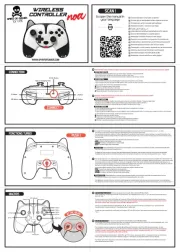
1 September 2025
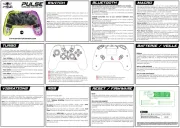
1 September 2025
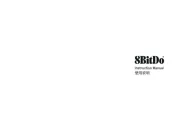
31 Augustus 2025
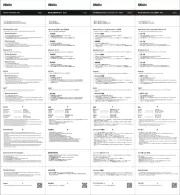
31 Augustus 2025
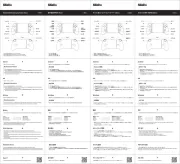
31 Augustus 2025
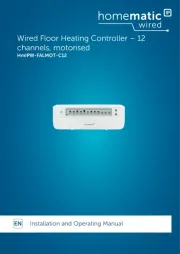
25 Augustus 2025
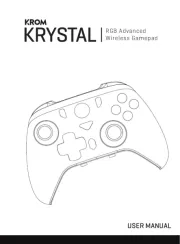
18 Augustus 2025
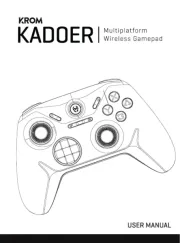
18 Augustus 2025